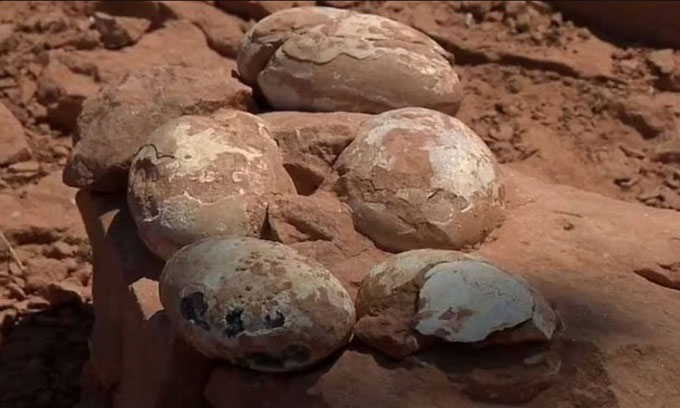Researchers have discovered a fossilized dinosaur egg clutch that could have hatched into carnivorous dinosaurs 60 to 80 million years ago if it had not been buried under sediment.

The intact eggs after 60 million years under sediment. (Photo: G1).
Five of the eggs were so well-preserved that the initial excavators believed they belonged to an ancient crocodile species found at the site. However, after further analysis by a research team led by paleontologist William Roberto Nava from the Marilia Museum, they determined that these eggs had a larger and thicker shell than crocodile eggs.
Nava noted that dinosaur eggs typically measure 10 to 13 cm in length and 5 to 8 cm in width, while ancient crocodile eggs do not exceed 5 cm in length. The shells of fossilized crocodile eggs are usually hollow or smooth, whereas dinosaur eggs have a textured shell with wavy patterns resembling writhing worms.
The dinosaur eggs excavated in Presidente Prudente, São Paulo, were preserved in layers of soil that gradually transformed into sandstone over time. This material acted as a natural protective layer, forming several layers of sand over millions of years, which helped to preserve the clutch until paleontologists unearthed them last year. However, it was not until December 2021 that they confirmed the eggs belonged to a dinosaur.
Previously, researchers discovered an exceptionally well-preserved dinosaur embryo in China. The embryo, named “Baby Yingliang”, was curled inside a fossilized egg found in the Hekou formation at the Shahe industrial area in Ganzhou City, Jiangxi Province. This specimen is one of the most complete dinosaur embryos ever known, positioned more like a bird embryo than that of a dinosaur.
Notably, Baby Yingliang was close to hatching, with its head tucked under its body, its back bent, and its feet positioned on either side. A team of paleontologists led by the University of Birmingham stated that Baby Yingliang belonged to a beaked, toothless theropod dinosaur known as “oviraptorosaurs.” The embryo measured 27 cm from head to tail and was curled inside a 17 cm long egg.


















































